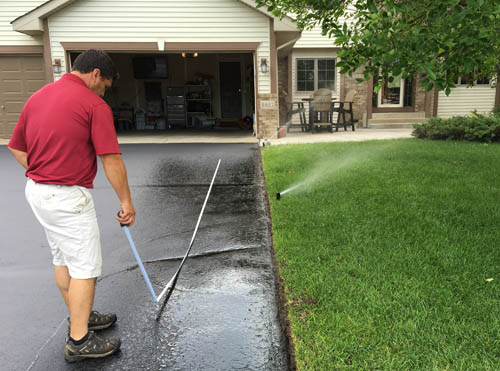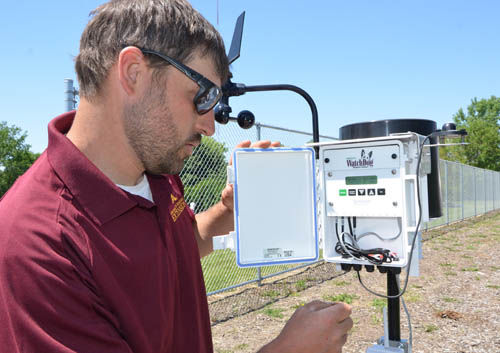
Despite abundant water resources in the state and region, our water supply is not endless
Sam Bauer’s family is in the tire business. But he’s all about grass—the kind you find in a lawn. As a teenager, Sam worked at the local golf course near his home in Wisconsin, falling for the outdoors and the lush green turf. He knew even then that this would be his lifelong pursuit.
“My passion is around putting less stuff on our lawns, including water,” he said. “We can have both: green grass and water savings.”
Today, Bauer is an Extension Educator at the University of Minnesota working on a two-year water efficiency project with the Metropolitan Council. Preserving our precious water supply is a goal both organizations share.
We don’t always treat water like the precious resource that it is. Data show that homeowners in the metro area use three times as much water during the summer months as compared with winter months. That’s because we’re tapping our water supply to keep our lawns green, often using lawn irrigation or sprinkling systems.
It’s a pattern that prompted the Council to partner with the U of M to survey residents about their lawn irrigation systems and practices, and test the performance of different grass species under dry conditions. Do we really need so much water for lawn irrigation?
Summary of irrigation practices survey
-
Residents prefer Kentucky Bluegrass, a species that requires more watering to stay green than lower maintenance grass species, like the fescues.
-
Many residents run their irrigation, or lawn sprinkler system, on an every-other-day schedule, regardless of the weather or soil moisture.
-
The average homeowner waters a significant portion of impervious surfaces, in other words, sidewalks, streets, driveways and patios.
-
Most irrigation systems have leaking sprinkler heads and many homeowners don’t have their systems checked for efficiency.
 Here’s Sam’s advice about your lawn irrigation system; “Turn it off! We’re overwatering, wasting water, and wasting money, and our lawns aren’t necessarily better for it.”
Here’s Sam’s advice about your lawn irrigation system; “Turn it off! We’re overwatering, wasting water, and wasting money, and our lawns aren’t necessarily better for it.”
He recommends manually turning irrigation systems on and off, as needed, to supplement rainfall during dry conditions. Or, investing in a smart irrigation controller that links to a weather station and automatically adjusts for weather conditions.
Tips for a luscious lawn and water savings
-
Check irrigation system sprinkler heads to ensure they’re working properly and repair them if they’re not.
-
Adjust sprinkler heads so they’re not watering hard surfaces.
-
Use grass species that require less water and maintenance.
-
Adjust your irrigation system as you change your landscaping.
-
Maintain grass at about 3.5 inches high.
-
Aerate soil to improve infiltration and infuse oxygen.
 Sam says there’s real value to managing lawns appropriately, and homeowners bear responsibility for using water resources efficiently and effectively.
Sam says there’s real value to managing lawns appropriately, and homeowners bear responsibility for using water resources efficiently and effectively.
It’s one of many strategies the Council embraces to protect the region’s abundant but vulnerable water supply now and in the future.
There’s no understating the value of water. Water is prosperity. Water is essential. Water is life.
You can help
You can save money—and water for future generations—by replacing your clock-based irrigation controller with a WiFi connected, WaterSense-certified Smart Controller. For more information, contact your water utility or visit the EPA WaterSense website.
The Council's Water Conservation Toolbox has useful resources for homeowners.